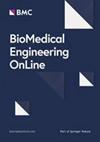A personalized clinical assessment: multi-sensor approach for understanding musculoskeletal health in the frail population
IF 2.9
4区 医学
Q3 ENGINEERING, BIOMEDICAL
引用次数: 0
Abstract
Sarcopenia is a muscle disorder causing a progressive reduction of muscle mass and strength, but the mechanism of its manifestation is still partially unknown. The three main parameters to assess are: muscle strength, muscle volume or quality and low physical performance. There is not a definitive approach to assess the musculoskeletal condition of frail population and often the available tests to be performed in those clinical bedridden patients is reduced because of physical impairments. In this paper, we propose a novel instrumental multi-domain and non-invasive approach during a well-defined protocol of measurements for overcoming these limitations. A group of 28 bedridden elder people, subjected to surgery after hip fracture, was asked to perform voluntary isometric contractions at the 80% of their maximum voluntary contraction with the non-injured leg. The sensor employed before and/or during the exercise were: ultrasound to determine the muscle architecture (vastus lateralis); force acquisition with a load cell placed on the chair, giving an indication of the muscle strength; surface electromyography (EMG) for monitoring muscular electrical activity; time-domain (TD) near-infrared spectroscopy (NIRS) for evaluating muscle oxidative metabolism. A personalized “report card” for each subject was created. It includes: the force diagram (both instantaneous and cumulative, expected and measured); the EMG–force diagram for a comparison between EMG derived median frequency and measured force; two graphs related to the hemodynamic parameters for muscle oxidative metabolism evaluation, i.e., oxy-, deoxy-, total-hemoglobin and tissue oxygen saturation for the whole exercise period. A table with the absolute values of the previous hemodynamic parameters during the rest and the ultrasound related parameters are also included. In this work, we present the union of protocols, multi-domain sensors and parameters for the evaluation of the musculoskeletal condition. The novelties are the use of sensors of different nature, i.e., force, electrical and optical, together with a new way to visualize and combine the results, by means of a concise, exhaustive and personalized medical report card for each patient. This assessment, totally non-invasive, is focused on a bedridden population, but can be extended to the monitoring of rehabilitation progresses or of the training of athletes.个性化临床评估:了解体弱人群肌肉骨骼健康状况的多传感器方法
肌肉疏松症是一种肌肉疾病,会导致肌肉质量和力量逐渐减少,但其表现机制仍有部分不明之处。评估的三个主要参数是:肌肉力量、肌肉体积或质量以及体能低下。目前还没有一种明确的方法来评估体弱人群的肌肉骨骼状况,而且由于体能障碍,临床卧床病人可进行的测试往往减少。在本文中,我们提出了一种新颖的多领域非侵入性仪器测量方法,并制定了明确的测量方案,以克服这些局限性。一组 28 名卧床不起的老年人在髋部骨折后接受了手术,他们被要求用未受伤的腿以最大自主收缩力的 80% 进行自主等长收缩。运动前和/或运动中使用的传感器包括:超声波,用于确定肌肉结构(侧阔肌);通过放置在椅子上的称重传感器采集力值,以显示肌肉强度;表面肌电图(EMG),用于监测肌肉电活动;时域近红外光谱(NIRS),用于评估肌肉氧化代谢。为每个受试者制作了个性化的 "成绩单"。其中包括:力图(包括瞬时力图和累积力图、预期力图和测量力图);EMG-力图,用于比较 EMG 导出的中位频率和测量力图;两张与用于评估肌肉氧化代谢的血液动力学参数有关的图表,即整个运动期间的氧饱和度、脱氧饱和度、总血红蛋白饱和度和组织氧饱和度。此外,我们还提供了一份表格,其中列有休息时先前血液动力学参数的绝对值以及超声波相关参数。在这项工作中,我们介绍了用于评估肌肉骨骼状况的协议、多域传感器和参数的组合。新颖之处在于使用了不同性质的传感器,即力传感器、电传感器和光学传感器,以及一种可视化和综合结果的新方法,为每位患者提供了一份简洁、详尽和个性化的医疗报告单。这种完全非侵入性的评估主要针对卧床不起的人群,但也可扩展到对康复进展或运动员训练的监测。
本文章由计算机程序翻译,如有差异,请以英文原文为准。
求助全文
约1分钟内获得全文
求助全文
来源期刊

BioMedical Engineering OnLine
工程技术-工程:生物医学
CiteScore
6.70
自引率
2.60%
发文量
79
审稿时长
1 months
期刊介绍:
BioMedical Engineering OnLine is an open access, peer-reviewed journal that is dedicated to publishing research in all areas of biomedical engineering.
BioMedical Engineering OnLine is aimed at readers and authors throughout the world, with an interest in using tools of the physical and data sciences and techniques in engineering to understand and solve problems in the biological and medical sciences. Topical areas include, but are not limited to:
Bioinformatics-
Bioinstrumentation-
Biomechanics-
Biomedical Devices & Instrumentation-
Biomedical Signal Processing-
Healthcare Information Systems-
Human Dynamics-
Neural Engineering-
Rehabilitation Engineering-
Biomaterials-
Biomedical Imaging & Image Processing-
BioMEMS and On-Chip Devices-
Bio-Micro/Nano Technologies-
Biomolecular Engineering-
Biosensors-
Cardiovascular Systems Engineering-
Cellular Engineering-
Clinical Engineering-
Computational Biology-
Drug Delivery Technologies-
Modeling Methodologies-
Nanomaterials and Nanotechnology in Biomedicine-
Respiratory Systems Engineering-
Robotics in Medicine-
Systems and Synthetic Biology-
Systems Biology-
Telemedicine/Smartphone Applications in Medicine-
Therapeutic Systems, Devices and Technologies-
Tissue Engineering
 求助内容:
求助内容: 应助结果提醒方式:
应助结果提醒方式:


